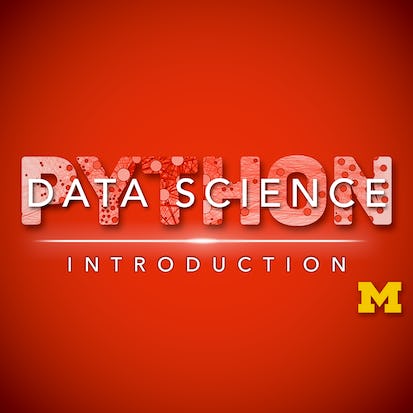- Level Professional
- Duration 35 hours
- Course by University of Michigan
-
Offered by

About
This course will introduce the learner to the basics of the python programming environment, including fundamental python programming techniques such as lambdas, reading and manipulating csv files, and the numpy library. The course will introduce data manipulation and cleaning techniques using the popular python pandas data science library and introduce the abstraction of the Series and DataFrame as the central data structures for data analysis, along with tutorials on how to use functions such as groupby, merge, and pivot tables effectively. By the end of this course, students will be able to take tabular data, clean it, manipulate it, and run basic inferential statistical analyses. This course should be taken before any of the other Applied Data Science with Python courses: Applied Plotting, Charting & Data Representation in Python, Applied Machine Learning in Python, Applied Text Mining in Python, Applied Social Network Analysis in Python.Modules
Introduction to the Course
2
Labs
- Your Personal Jupyter Notebook Workspace
- Module 1 Jupyter Notebooks
10
Videos
- Introduction to Specialization
- Introduction to the Course
- The Coursera Jupyter Notebook System
- Python Functions
- Python Types and Sequences
- Python More on Strings
- Python Demonstration: Reading and Writing CSV files
- Python Dates and Times
- Advanced Python Objects, map()
- Advanced Python Lambda and List Comprehensions
5
Readings
- Syllabus
- Notice for Auditing Learners: Assignment Submission
- Help Us Learn More About You!
- Week 1 Textbook Reading Assignment (Optional)
- 50 years of Data Science, David Donoho (Optional)
Fundamentals of Data Manipulation
2
Videos
- Numerical Python Library (NumPy)
- Manipulating Text with Regular Expression
1
Readings
- Regular Expression Operations documentation
Week 1 - Assignment
- Assignment 1
1
Assignment
- Quiz 1
Introduction to Pandas and Series Data
1
Labs
- Module 2 Jupyter Notebooks
3
Videos
- Introduction to Pandas
- The Series Data Structure
- Querying a Series
1
Readings
- Week 2 Reading Assignments (Optional)
DataFrame
6
Videos
- DataFrame Data Structure
- DataFrame Indexing and Loading
- Querying a DataFrame
- Indexing Dataframes
- Missing Values
- Example: Manipulating DataFrame
Week 2 - Assignment
- Assignment 2
1
Assignment
- Quiz 2
More Data Processing with Pandas
1
Labs
- Module 3 Jupyter Notebooks
6
Videos
- Merging Dataframes
- Pandas Idioms
- Group by
- Scales
- Pivot Table
- Date/Time Functionality
1
Readings
- Week 3 Reading Assignments (Optional)
Week 3 - Assignment
- Assignment 3
1
Assignment
- Quiz 3
Beyond Data Manipulation
1
Labs
- Module 4 Jupyter Notebooks
2
Videos
- Basic Statistical Testing
- Other Forms of Structured Data
3
Readings
- Science Isn't Broken: p-hacking
- Goodhart's Law (Optional)
- The 5 Graph Algorithms that you should know
Week 4 - Assignment
- Assignment 4
1
Assignment
- Final Quiz
3
Readings
- Post-course Survey
- Keep Learning with Michigan Online!
- Progress note from Christopher Brooks
Auto Summary
"Introduction to Data Science in Python" offers a comprehensive foundation in Python programming and data manipulation. Led by experienced instructors from Coursera, this course covers essential skills like using lambdas, handling CSV files, and leveraging the numpy and pandas libraries. Over 2100 minutes, learners will master data cleaning, manipulation, and basic statistical analysis. Ideal for professionals, it serves as a prerequisite for advanced courses in the Applied Data Science with Python series. Flexible subscription options include Starter, Professional, and Paid plans, catering to various learning needs.

Christopher Brooks


